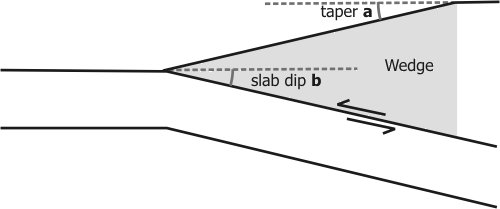In my post about misconceptions in geology, I introduced the idea that rather than a specific prediction, seismologists concentrate more on estimating the likelihood of large or destructive earthquakes over a certain time period, or the seismic hazard. Subduction zones accommodate large amounts of relative motion between the two plates they separate. Also, this relative motion mostly occurs on a single shallowly-dipping fault, with a large surface area (sometimes called a megathrust), where one plate is thrust underneath the other. Both of these features suggest that the seismic hazard of subduction zones can be quite high. In an earthquake cycle, the area around a fault deforms elastically until enough strain energy is built up to overcome frictional forces across the fault itself, and this energy is released in an earthquake. If large amounts of motion are being accommodated by a single fault, the strain build-up will be large and rapid, and could be potentially released in a single large earthquake.
However, it turns out that not all subduction zones, or even sections of subduction zones, are created equal. Along some segments, infrequent large ruptures which can potentially cause tsunamis occur, in other places earthquakes occur more often and are therefore smaller (because there has been less time for strain to build up across the fault). The seismic coupling of the subduction thrust, the ratio of the estimated slip released in earthquakes to the overall relative plate motion, is also quite variable, implying that at some subduction zones a significant amount of deformation is being accommodated either by aseismic slip (which is gradual and therefore does not cause earthquakes) on the subduction thrust, or by deformation within the accretionary wedge. Understanding the causes of this variation is obviously important for accurate estimates of the seismic hazard at subduction zones. In this month’s Geology, Fuller et al.[1] provide some insight into this problem by using, and extending, the concept of the critical or Coulomb wedge.
The diagram above illustrates a simple model of a subduction zone, with a basal thrust dipping at angle b and a wedge of accreted sediments on the overriding plate. In this configuration, where deformation occurs is governed by the balance between the frictional strength of the basal thrust, and the strength and shape of the accretionary wedge. If the rocks in the wedge are weaker than the thrust, then some inter-plate motion can be accommodated by folding and small-scale faulting in the wedge, rather than causing strain to build up across the subduction thrust, and reduce the risk of large earthquakes. But this is only true if the slope, or taper, of the wedge (a in the figure above) is below a certain value. Once the wedge reaches this critical taper its internal strength cannot support steeper slopes against the force of gravity; it can therefore no longer deform internally, and deformation will now be concentrated on the basal thrust.
This model provides some insight into why seismic coupling might vary along a subduction zone; areas of low seismic coupling might be areas where the wedge has not yet reached a critical taper, allowing more deformation to be accommodated away from the basal thrust. Also, wedges with steep topography may indicate a stronger basal thrust; the stronger the subduction thrust is, the greater the frictional forces that need to be overcome, and the larger the eventual earthquake can be.
Fuller et al. were investigating the observation that along some subduction zones, areas of high seismic coupling (also known as asperities) are associated with forearc basins, which are formed by downwarping of rocks on the upper plate. They realised, and confirmed with some numerical modelling, that if you take into account the increasing dip of the slab, b, away from the trench, formation of these basins is actually a consequence of critical wedge theory; as b increases, the critical taper decreases and can eventually become negative, causing the slope to change direction and form a forearc basin (factors such as the overall strength of the basal thrust and the wedge also affect the critical taper, so this does not have to happen).
Further modelling shows that if this basin was then filled with sediment, the taper of the wedge would be increased a long way above critical. This allows larger strains to build up on the subduction thrust, because there is no possibility that any deformation can be accommodated in the wedge. This neatly explains why subduction zones with well developed forearc basins show a higher degree of seismic coupling.
I really like the way that the authors have taken a simple model, which I learnt about as an undergrad, applied it to a more realistic situation, and used it to explain some aspects of subduction zones in a new way.
[1] Fuller, C.W, et al. (2006). Geology 34(2), p 65-68.
22 February, 2006
The critical wedge and seismic hazards at subduction zones
Posted by
Chris R
at
2:15 pm
![]()
Labels: earthquakes, geohazards, geology
Subscribe to:
Post Comments (Atom)




No comments:
Post a Comment